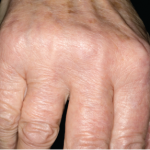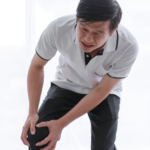Eaton et al. set out to describe the prevalence, incidence and progression of radiographic and symptomatic hand osteoarthritis (OA), and to evaluate differences according to age, sex, race and other risk factors.


Eaton et al. set out to describe the prevalence, incidence and progression of radiographic and symptomatic hand osteoarthritis (OA), and to evaluate differences according to age, sex, race and other risk factors.

John Nawrocki, MD, Kevin Hess, DO, & Maryah Mansoor, MBBS |
Lipoma arborescens is a rare, benign intra-articular lesion characterized by diffuse replacement of synovial tissue by mature adipocytes, causing a villous lipomatous proliferation of the synovial membrane.1 Typically, this is a monoarticular condition, with the knee being the most commonly affected although it has been rarely reported to occur in an oligo-/polyarticular fashion and in…

In the ACR Convergence 2021 session on Updates in OA, presenters discuss the debate over OA phenotypes vs. endotypes, as well as note that research conducted over the past 20 years yields a better understanding of the pathogenesis of OA.
Marilynn Larkin |
NEW YORK (Reuters Health)—In patients with knee osteoarthritis (OA), telehealth-delivered exercise and diet programs are superior to electronic health information for reducing pain and improving function, although the contribution of diet is modest, a randomized trial shows.1 “This research provides evidence from a large clinical trial to help tease out how much benefit dietary weight…

Kade L. Paterson, PhD, BPod, BAppSci(Hons), Marian T. Hannan, DSc, MPH, Lara Chapman, MSc, BPod, Edward Roddy, DM, FRCP, Hylton B. Menz, PhD, BPod, & Catherine Bowen, PhD, BPod |
The high prevalence and significant burden of osteoarthritis (OA) are well known. But it’s becoming apparent that OA research efforts don’t necessarily match disease prevalence or disability. The International Foot and Ankle Osteoarthritis Consortium (IFOAC) is an international organization of volunteers that seeks to highlight a major and often overlooked problem in OA research—foot and…

Convex-walking shoes, dietary supplements, advancements in nerve growth factor inhibitors and more—Xavier Chevalier gave an overview and new insights into treatments for osteoarthritis.
Marilynn Larkin |
NEW YORK (Reuters Health)—Non-surgical care for knee osteoarthritis (OA) is uncommon among older adults, especially in regions of the U.S. where total knee arthroplasty rates are high, a large retrospective analysis shows.1 “As rheumatologists, we often think of knee arthroplasty as the last resort, after patients have tried and failed more conservative treatments, such as…
Lisa Rapaport |
(Reuters Health)—Total knee replacement surgery can be a cost-effective procedure for patients with severe obesity and osteoarthritis (OA), even when they also have comorbidities such as cardiovascular disease or type 2 diabetes, a new study suggests. Researchers did a cost-benefit analysis for two patient populations (over 65 years, and age 50 to 65) who had…

High-intensity strength training may be no more beneficial than low-intensity strength training at improving pain and joint compression in patients with knee osteoarthritis, according to a recent study.

In a controlled, large-cohort, longitudinal study from Canada, Atiquazzaman et al. found that use of non-steroidal anti-inflammatory drugs (NSAIDs) substantially contributes to increased cardiovascular disease risk among people with osteoarthritis (OA).1 This is the first study to evaluate the mediating role that NSAIDs play in the association between OA and cardiovascular disease (CVD), and the…